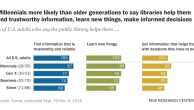Findings
The population of e-book readers is growing. In the past year, the number of those who read e-books increased from 16% of all Americans ages 16 and older to 23%. At the same time, the number of those who read printed books in the previous 12 months fell from 72% of the population ages 16 and older to 67%.
Overall, the number of book readers in late 2012 was 75% of the population ages 16 and older, a small and statistically insignificant decline from 78% in late 2011.
The move toward e-book reading coincides with an increase in ownership of electronic book reading devices. In all, the number of owners of either a tablet computer or e-book reading device such as a Kindle or Nook grew from 18% in late 2011 to 33% in late 2012. As of November 2012, some 25% of Americans ages 16 and older own tablet computers such as iPads or Kindle Fires, up from 10% who owned tablets in late 2011. And in late 2012 19% of Americans ages 16 and older own e-book reading devices such as Kindles and Nooks, compared with 10% who owned such devices at the same time last year.

This move toward e-books has also affected libraries. The share of recent library users1 who have borrowed an e-book from a library has increased from 3% last year to 5% this year.2 Moreover, awareness of e-book lending by libraries is growing. The share of those in the overall population who are aware that libraries offer e-books has jumped from 24% late last year to 31% now.3
These latest figures come from a survey by the Pew Research Center’s Internet & American Life Project which was conducted on October 15-November 10, 2012 among 2,252 Americans ages 16 and older. The margin of error is plus or minus 2.3 percentage points.
Who reads e-books
In the book-reading population, those most likely to read e-books include those with college or graduate degrees, those who live in households earning more than $75,000, and those whose ages fall between 30 and 49.
The tables below, which show increases among various demographic groups, are based on those who say they had read a book in the past 12 months, not the full population of those ages 16 and older.

Who read books in the past 12 months
In the new Pew Internet survey 75% of Americans ages 16 and older said they had read a book in any platform in the previous 12 months. That is not statistically significantly different from the 78% who in late 2011 said in a survey they had read a book in the previous 12 months. Of them:
- 89% of the book readers said they had read a printed book. This translates into 67% of all those ages 16 and older.
- 30% of the book readers said they had read an e-book. This translates into 23% of all those ages 16 and older.
- 17% of the book readers said they had listened to an audio book. This translates into 13% of all those ages 16 and older.
All told, those book readers consumed a mean (average) of 15 books in the previous 12 months and a median (midpoint) of 6 books — in other words, half had read fewer than six and half had read more than six. That breaks down as follows:
- 7% of Americans ages 16 and older read one book in the previous 12 months
- 14% had read 2-3 books in that time block
- 12% had read 4-5 books in that time block
- 15% had read 6-10 books in that time block
- 13% had read 11-20 books in that time block
- 14% had read 21 or more books in that time block

E-book borrowing from libraries
This move toward e-books has also affected libraries. The share of recent library users who have borrowed an e-book from a library has increased from 3% last year to 5% this year.
Beyond that, there is growing public awareness that the vast majority of public libraries now lend e-books. In the entire population of those ages 16 and older, the number who are aware that libraries offer e-book loans increased from 24% last year to 31% now. At the same time, there has been a drop in the number of people who do not know whether their local library has an e-book borrowing program. Now, 57% say they don’t know if their library offers e-books. Last year, 63% of those ages 16 and above did not know if their library offered e-books for borrowing.4



